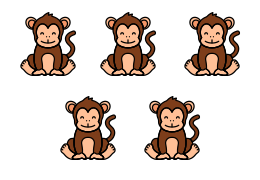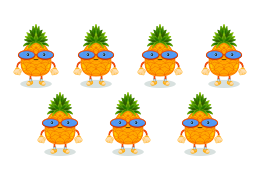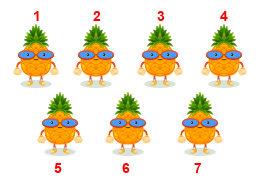Numbers To 10
In this article, we will learn numbers from \(0\) to \(10\). At the end of the article, you should be able to identify these numbers, and read and write them. We will also count and compare these numbers.
The learning objectives will be as follows:
- Reading and writing in numerals and words
- Comparing the number of items in the sets
1. Reading and writing in numerals and words
Numbers are very important. You use them to count the number of candies or the number of pencils you have. Our birthdays fall on a date, which is a number too! The clock shows the time of the day with numbers. Can you think of more examples?
We are going to learn both – numerals and words of numbers.
- \(0\) means nothing. \(0\) is the numeral form and in word form, it is spelt as Z E R O.
 How many chicks do you see?
How many chicks do you see?
There is one chick. Its numeral form is \(1\) and in word form, it is O N E.

 Count the number of chicks here.
Count the number of chicks here.
There are two chicks. The numeral form is \(2\) and in word form, it is T W O.


 How many do you see now?
How many do you see now?
There are three chicks. The numeral form is \(3\) and in word form, it is T H R E E.



 Can you count these?
Can you count these?
There are four chicks. The numeral form is \(4\) and in word form, it is F O U R.




 How many do you see now?
How many do you see now?
There are five chicks. The numeral form is \(5\) and in word form, it is F I V E.
Do remember to learn both the numerals and their spellings. Look at the table below to revise the numbers we have just learned!
| NUMBER OF CHICKS | NUMERALS | WORDS |
|---|---|---|
| 0 | Zero | |
 |
1 | One |
  |
2 | Two |
   |
3 | Three |
    |
4 | Four |
     |
5 | Five |
Moving on, let’s learn the next five numbers as well.
| NUMBER OF CHICKS | NUMERALS | WORDS |
|---|---|---|
      |
6 | Six |
       |
7 | Seven |
        |
8 | Eight |
         |
9 | Nine |
          |
10 | Ten |
Question 1:
There are __________ monkeys shown on the right.

- 5
- 6
- 7
- 4
(Hint: Count them one at a time. Start with the top row and then go to the row below.)
Solution:
Answer :
(1) 5

Question 2:
Count and write the number of pineapples in words.

- Six
- Eight
- Three
- Seven
(Hint: Make sure you do not count any of the pineapples twice. Start counting them from the top row to the row below.)
Solution:

Answer :
(4) Seven
Question 3:
Which of the following sets shows ten apples?
| 1. | 2. | ||
| 3. | 4. |
(Hint: Count the apples carefully and avoid counting an apple twice. Do not miss the ones at the bottom of the bowls. Make sure you count each set before choosing the correct answer.)
Solution:
Answer :
(1)
Question 4:
Which of the following sets does not show four items?
| 1. | 2. | ||
| 3. | 4. |
Solution:
Options 1, 2, and 3 have 4 items each, while option 4 has 7 items.
Answer :
(4)
Question 6:
What is the missing number in the number pattern below?
- 6
- 8
- 9
- 4
(Hint: You have to write the number that comes after 5 and before 7. To solve this pattern question, count from 0, 1, 2… to 10 and write them down.)
Solution:
0, 1, 2, 3, 4, 5, 6, 7, 8, 9, 10. Once you write the numbers down, you will notice that number 6 comes after number 5 and before number 7.
Answer :
(1) 6
Question 7:
What is the missing number in the number pattern below?
- 5
- 6
- 7
- 10
Solution:
Since the numbers are decreasing, we count back starting from 10.
Answer :
(4) 10
Question 8:
What are the missing numbers in the number pattern below?
- 0, 4
- 2, 4
- 0, 6
- 4, 6
(Hint: Choose the correct option carefully as there are two blank boxes.)
Solution:
The numbers missing are 0, 1, 2, 3, 4, 5.
Answer:
(1) 0, 4
Question 9:
What are the missing numbers in the number pattern below?
- 8, 6
- 8, 3
- 6, 3
- 6, 1
Solution:
Since the numbers are decreasing, we count back starting from 7:
7, 6, 5, 4, 3, 2
Answer :
(3) 6, 3
2. Comparing the number of items in the sets
Let’s learn how to compare numbers. We compare them by matching.
Example 1:
Match each saucer to a teacup.
We see that each tea cup is matched to a saucer. There is no extra tea cup or saucer left. This means that they are of the same number.
Example 2:
Match each spoon to a plate.
The last two plates do not have a spoon.
The number of spoons is fewer than the number of plates, as 3 is smaller than 5.
Question 1:
Fill in the blanks.
| Group A | Group B |
- Group has more.
- is greater than .
- Group has fewer.
- is fewer than .
Solution:
Match each dog to a bone.
After matching, there are 2 bones left.
Answer:
- Group B has more.
- 10 is greater than 8 .
- Group A has fewer.
- 8 is fewer than 10 .
Question 2:
Let’s match, count and compare the following.
Fill in the blanks.
- Group has more.
- is greater than .
- Group has fewer.
- is smaller than .
- Group A has more.
- Group B has fewer.
Solution:
Match each cat to a toy.
After matching, there are 4 cats left.
Answer :
- Group A has more.
- 9 is greater than 5 .
- Group B has fewer.
- 5 is smaller than 9 .
- Group A has 4 more.
- Group B has 4 fewer.
Question 3:
Which two sets have the same number of items?
- A and B
- A and D
- B and C
- B and D
Solution:
Group A has 6 items.
Group B has 7 items.
Group C has 5 items.
Group D has 6 items.
Answer:
(2) A and D
Question 4:
9 is smaller than __________.
- 1
- 2
- 4
- 10
Solution:
9 is greater than 1, 2 and 4.
Answer :
(4) 10
Question 5:
Which of the following is the smallest set?
Solution:
Set 1 has four apples. Set 2 has three apples. Set 3 has six apples. Set 4 has five apples. The smallest number out of them is 3.
Answer:
(2)
Question 6:
Which cap has the greatest number ?
- 8
- 6
- 3
- 4
Solution:
The cap with 8 has the greatest number.
Answer :
(1) 8
Question 7:
Which of the following is the greatest number?
- Ten
- Nine
- Eight
- Seven
Solution:
- Ten is 10
- Nine is 9
- Eight is 8
- Seven is 7
The greatest number among them is 10.
Answer:
(1) Ten
Question 8:
Look at the numbers below. Arrange the numbers in order, starting with the smallest.
- 0, 4, 6, 10
- 4, 6, 10, 0
- 10, 6, 0, 4
- 10, 6, 4, 0
Solution:
Let’s identify the smallest number from the given options.
0 is the smallest, followed by 4, then 6 and then 10.
Answer :
(1) 0, 4, 6, 10
Question 9:
Look at the numbers below. Arrange the numbers in order, starting with the greatest.
- 2, 5, 8, 9
- 2, 5, 9, 8
- 9, 8, 2, 5
- 9, 8, 5, 2
Solution :
9 is the greatest, followed by 8, 5 and 2.
Answer :
(4) 9, 8, 5, 2
Test Your Skill
Question 1:
How many more?
| Set A | Set B |
| Set __________ has __________ more. | |
- Set A has 2 more.
- Set B has 3 more.
- Set A has 3 more.
- Set B has 6 more.
Solution:
Set A has 3 cupcakes. Set B has 6 doughnuts. Count the extras.
You will see that Set B has 3 more than Set A.
Answer :
(2)
Question 2:
How many fewer?
| Set A | Set B |
| Set __________ has __________ fewer . | |
- Set A has 7 fewer.
- Set B has 5 fewer.
- Set A has 5 fewer.
- Set B has 2 fewer.
Solution:
Set A has 7 candies and Set B has 2 ice cream cones. Count the extra.
Answer :
(2)
Conclusion
Hope you had fun! Let’s summarise what we learnt in this article:
- Reading and writing numbers in numerals and words.
- Comparing the number of items in the sets.
 SG
SG  VN
VN 












